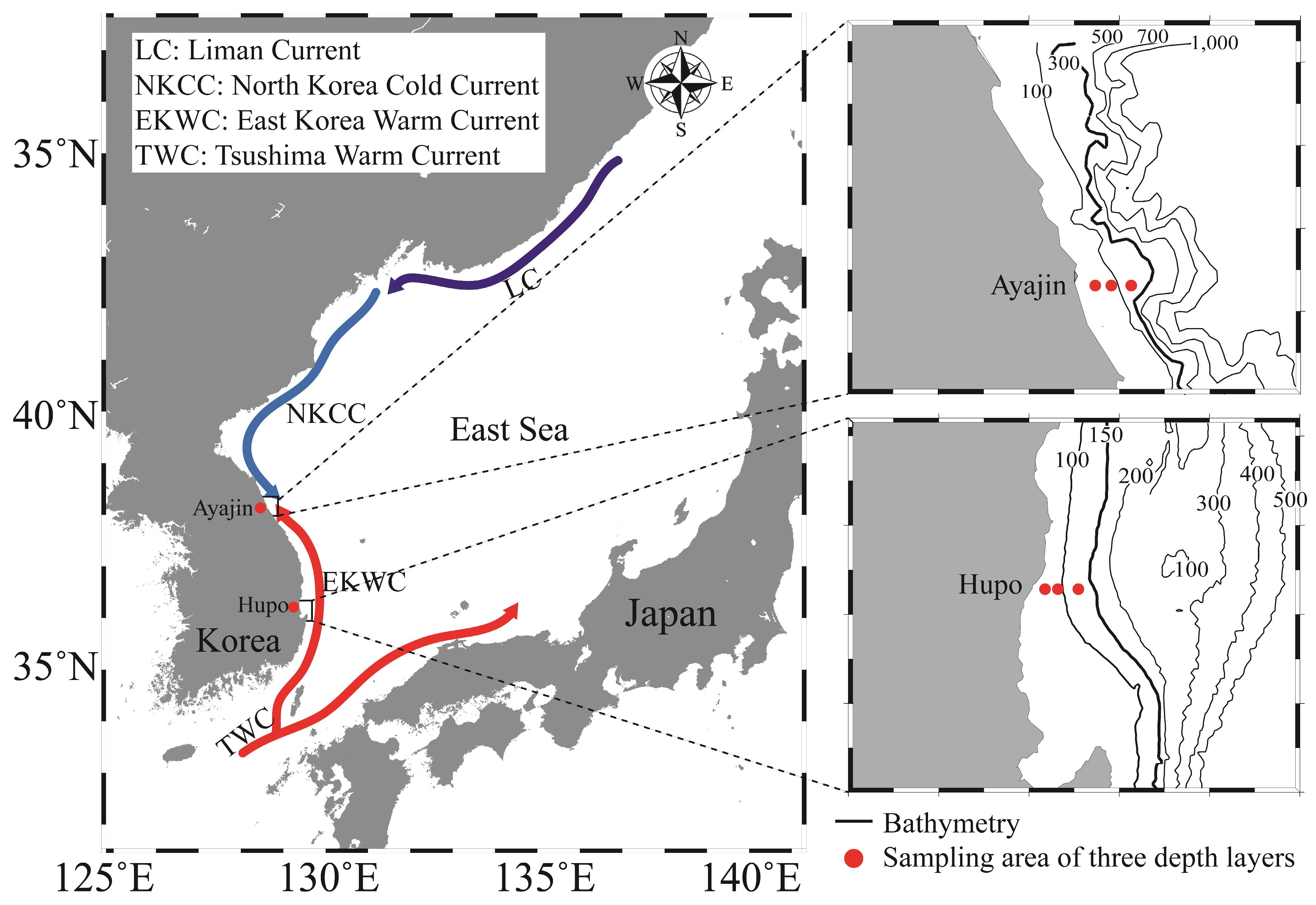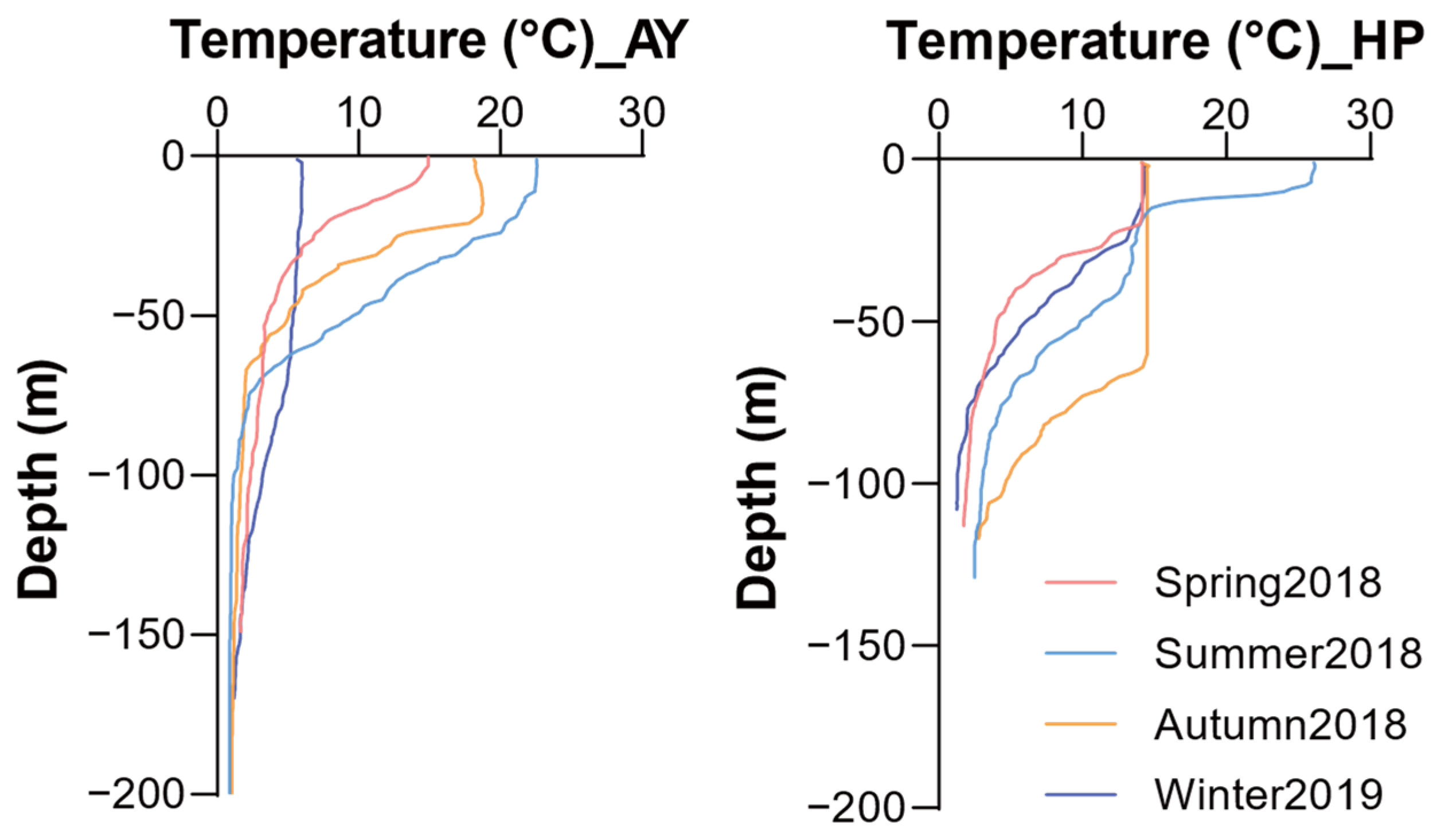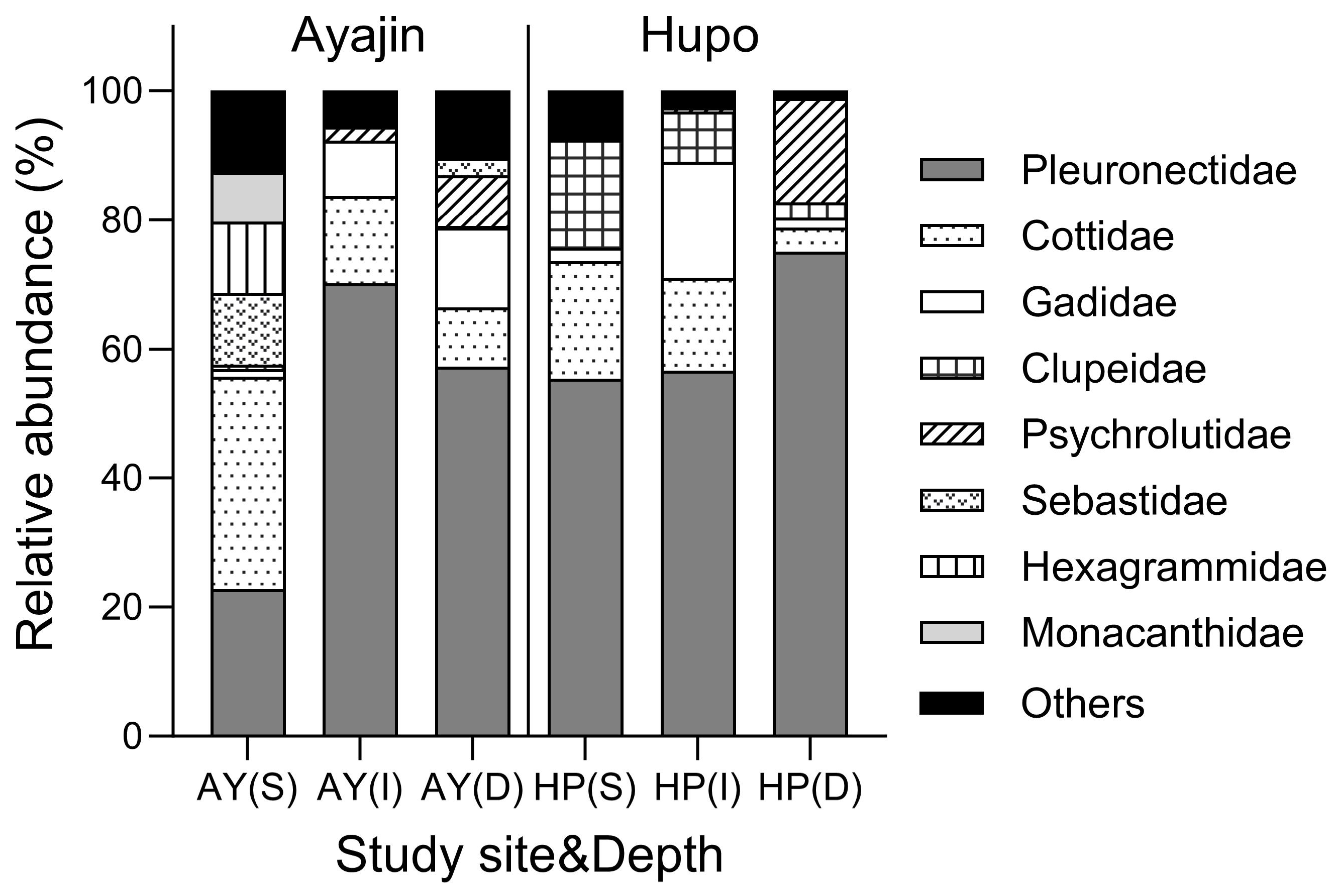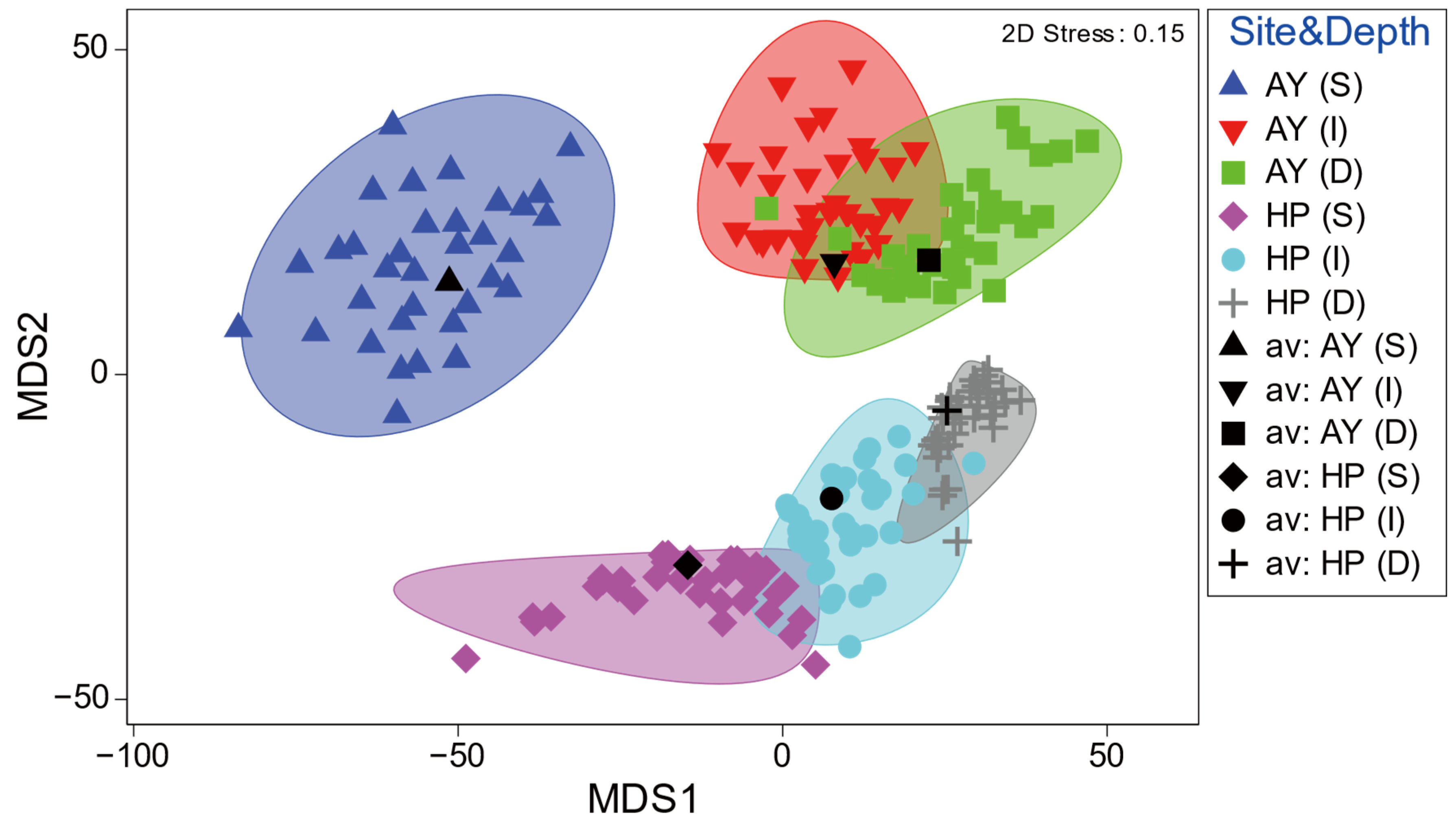Spatial Dynamics of Demersal Fish Assemblages off the Korean Coast in the East Sea
Abstract
:Simple Summary
Abstract
1. Introduction
2. Materials and Methods
2.1. Study Area
2.2. Sampling
2.3. Data Analyses
3. Results
3.1. Vertical Trends of Water Temperature in Northern and Southern Sites
3.2. Fish Species Composition
3.3. Variations in Species Richness, Abundance, and Diversity
3.4. Fish Assemblage Structure
4. Discussion
5. Conclusions
Supplementary Materials
Author Contributions
Funding
Institutional Review Board Statement
Informed Consent Statement
Data Availability Statement
Acknowledgments
Conflicts of Interest
References
- Chen, Z.; Liang, C.; Xian, W. Spatial and temporal variations in autumn fish assemblages in the offshore waters of the Yangtze Estuary. Diversity 2023, 15, 669. [Google Scholar] [CrossRef]
- Tessier, A.; Descloux, S.; Lae, R.; Cottet, M.; Guedant, P.; Guillard, J. Fish assemblages in large tropical reservoirs: Overview of fish population monitoring methods. Rev. Fish. Sci. Aquac. 2016, 24, 160–177. [Google Scholar] [CrossRef]
- Lauria, V.; Gristina, M.; Fiorentino, F.; Attrill, M.J.; Garofalo, G. Spatial management units as an ecosystem-based approach for managing bottom-towed fisheries in the central Mediterranean Sea. Front. Mar. Sci. 2020, 7, 233. [Google Scholar] [CrossRef]
- Lee, C.I.; Jung, H.K.; Kwon, S.M.; Han, M.H.; Seol, K.S.; Park, J.M. Depth-dependent variability of fish fauna in the coastal waters off Hupo, East Sea. Korean J. Ichthyol. 2018, 30, 36–45. [Google Scholar] [CrossRef]
- Georgios, A.O.; Touloumis, K.; Koutrakis, E.; Tsikliras, A.C. Fish assemblages along a bathymetric gradient in the northern Aegean Sea: An ecomorphological approach. Deep Sea Res. Part I Oceanogr. Res. Pap. 2023, 207, 104223. [Google Scholar] [CrossRef]
- Olivar, M.P.; Beckley, L.E. Latitudinal variation in diversity and abundance of mesopelagic fishes associated with change in oceanographic variables along 110 °E, south-east Indian Ocean. Deep Sea Res. Part II Top. Stud. Oceanogr. 2022, 198, 105053. [Google Scholar] [CrossRef]
- Mont’Alverne, R.; Pereyra, P.E.R.; Garcia, A.M. Trophic segregation of a fish assemblage along lateral depth gradients in a subtropical coastal lagoon revealed by stable isotope analyses. J. Fish Biol. 2016, 89, 770–792. [Google Scholar] [CrossRef] [PubMed]
- González-Sansón, G.; Aguilar-Betancourt, C.M.; Kosonoy-Aceves, D. Influence of sediment granulometry and salinity on the composition of an estuarine fish assemblage in the Mexican Tropical Pacific. Rev. Biol. Trop. 2018, 66, 1065–1077. [Google Scholar] [CrossRef]
- Máñez-Crespo, J.; Tomas, F.; Fernández-Torquemada, Y.; Royo, L.; Espino, F.; Antich, L.; Bosch, N.E.; Castejón, I.; Hernan, G.; Marco-Méndez, C.; et al. Variation in fish abundance, diversity and assemblage structure in seagrass meadows across the Atlanto-Mediterranean province. Diversity 2022, 14, 808. [Google Scholar] [CrossRef]
- Roset, N.; Grenouillet, G.; Goffaux, D.; Pont, D.; Kestemont, P. A review of existing fish assemblage indicators and methodologies. Fish. Manag. Ecol. 2007, 14, 393–405. [Google Scholar] [CrossRef]
- Park, J.M.; Riedel, R.; Ju, H.H.; Choi, H.C. Fish assemblage structure comparison between freshwater and estuarine habitats in the lower Nakdong River, South Korea. J. Mar. Sci. Eng. 2020, 8, 496. [Google Scholar] [CrossRef]
- Jung, H.-K.; Rahman, S.M.M.; Choi, H.-C.; Park, J.-M.; Lee, C.-I. Recent Trends in Oceanic Conditions in the Western Part of East/Japan Sea: An analysis of climate regime shift that occurred after the late 1990s. J. Mar. Sci. Eng. 2021, 9, 1225. [Google Scholar] [CrossRef]
- Lee, C.-I.; Jung, Y.-W.; Jung, H.-K. Response of spatial and temporal variations in the Kuroshio Current to water column structure in the western part of the East Sea. J. Mar. Sci. Eng. 2022, 10, 1703. [Google Scholar] [CrossRef]
- Park, Y.-G.; Cho, Y.-K.; Kim, K. A hydraulic model of the Korea Strait bottom cold current. J. Oceanogr. 1995, 51, 713–727. [Google Scholar] [CrossRef]
- Lee, J.-Y.; Kang, D.-J.; Kim, I.-N.; Rho, T.; Lee, T.; Kang, C.-K.; Kim, K.-R. Spatial and temporal variability in the pelagic ecosystem of the East Sea (Sea of Japan): A review. J. Mar. Syst. 2009, 78, 288–300. [Google Scholar] [CrossRef]
- Im, S.O. Feeding Relationship and Trophic Partitioning of Demersal Fish Assemblage in the Coastal Waters of East Sea; Pukyong National University: Busan, Republic of Korea, 2019. [Google Scholar]
- Ryu, J.H.; Kim, P.-K.; Kim, J.K.; Kim, H.J. Seasonal variation of species composition of fishes collected by gill net and set net in the middle East Sea of Korea. Korean J. Ichthyol. 2005, 17, 279–286. [Google Scholar]
- Kang, P.J.; Kim, C.K.; Hwang, S.W. Fish assemblages collected by bottom trammel gill net around Gampo in the East Sea of Korea. Korean J. Environ. Biol. 2015, 33, 27–33. [Google Scholar] [CrossRef]
- Ryu, J.-H.; Kim, J.-K. Diversity and assemblage structure of marine fish species collected by set net in Korean Peninsula during 2009–2013. Ocean Sci. J. 2020, 55, 581–591. [Google Scholar] [CrossRef]
- Kim, D.; Ji, R.; Park, H.J.; Feng, Z.; Jang, J.; Lee, C.l.; Kang, Y.-H.; Kang, C.-K. Impact of shifting subpolar front on phytoplankton dynamics in the western margin of East/Japan Sea. Front. Mar. Sci. 2021, 8, 703. [Google Scholar] [CrossRef]
- Kang, D.-J.; Kim, K.; Kim, K.-R. The past, present and future of the East/Japan sea in change: A simple moving-boundary box model approach. Prog. Oceanogr. 2004, 61, 175–191. [Google Scholar] [CrossRef]
- Lee, E.-Y.; Park, K.-A. Change in the Recent Warming Trend of sea surface temperature in the East Sea (Sea of Japan) over decades (1982–2018). Remote Sens. 2019, 11, 2613. [Google Scholar] [CrossRef]
- Tian, Y.; Kidokoro, H.; Watanabe, T. Long-term changes in the fish community structure from the Tsushima warm current region of the Japan/East Sea with an emphasis on the impacts of fishing and climate regime shift over the last four decades. Prog. Oceanogr. 2006, 68, 217–237. [Google Scholar] [CrossRef]
- Chiba, S.; Saino, T. Variation in mesozooplankton community structure in the Japan/East Sea (1991–1999) with possible influence of the ENSO scale climatic variability. Prog. Oceanogr. 2003, 57, 317–339. [Google Scholar] [CrossRef]
- Jung, S.; Pang, I.-C.; Lee, J.-h.; Choi, I.; Cha, H.K. Latitudinal shifts in the distribution of exploited fishes in Korean waters during the last 30 years: A consequence of climate change. Rev. Fish Biol. Fish. 2014, 24, 443–462. [Google Scholar] [CrossRef]
- Son, M.H.; Lee, C.I.; Park, J.M.; Kim, H.J.; Riedel, R.; Hwang, I.; Kim, Y.-N.; Jung, H.K. The northward habitat expansion of the Korean Top Shell Turbo sazae (Gastropoda: Vetigastropoda: Turbinidae) in the Korean Peninsula: Effects of increasing water temperature. J. Mar. Sci. Eng. 2020, 8, 782. [Google Scholar] [CrossRef]
- Kim, Y.-U.; Kim, Y.-S.; Ahn, G.; Kim, J.-K. New record of the two carangid fishes (Perciformes, Carangidae) from Korea. Korean J. Ichthyol. 1999, 11, 17–22. [Google Scholar]
- Myoung, S.H.; Myoung, J.-G.; Woo, M.-S.; Kim, M.J.; Kang, M.G.; Park, J.M. New record of Chromis weberi (Actinopterygii: Ovalentaria: Pomacentridae) from Jeju Island, southern Korea. Acta Ichthyol. Piscat. 2023, 53, 89–94. [Google Scholar] [CrossRef]
- Naganuma, K. The sea of Japan as the natural environment of marine organisms. Bull. Jpn. Sea Natl. Fish. Res. Inst. 2000, 50, 1–42. [Google Scholar]
- Choi, K.H.; Han, M.H.; Kang, C.-K.; Park, J.M.; Choi, J.H.; Park, J.-H.; Sohn, M.H.; Baeck, G.W.; Choy, E.J.; Lee, C.I. Seasonal variations in species composition of fish assemblage collected by trammel net in coastal waters of the East Sea. J. Korean Soc. Fish. Ocean Technol. 2012, 48, 415–427. [Google Scholar] [CrossRef]
- Shannon, C.; Weaver, W. The Mathematical Theory of Communication; Illinois University Press: Urbana, IL, USA, 1949. [Google Scholar]
- Clarke, K.R.; Somerfield, P.J.; Chapman, M.G. On resemblance measures for ecological studies, including taxonomic dissimilarities and a zero-adjusted Bray-Curtis coefficient for denuded assemblages. J. Exp. Mar. Biol. Ecol. 2006, 330, 55–80. [Google Scholar] [CrossRef]
- Anderson, M.J.; Walsh, D.C.I. PERMANOVA, ANOSIM, and the Mantel test in the face of heterogeneous dispersions: What null hypothesis are you testing? Ecol. Monogr. 2013, 83, 557–574. [Google Scholar] [CrossRef]
- Anderson, M.J. A new method for non-parametric multivariate analysis of variance. Austral Ecol. 2001, 26, 32–46. [Google Scholar] [CrossRef]
- Anderson, M.; Gorley, R.; Clarke, K. PERMANOVA+ for PRIMER: Guide to Software and Statistical Methods; PRIMER-E Plymouth Marine Laboratory: Plymouth, UK, 2008. [Google Scholar]
- Anderson, M.J.; Willis, T.J. Canonical analysis of principal coordinates: A useful method of constrained ordination for ecology. Ecology 2003, 84, 511–525. [Google Scholar] [CrossRef]
- Clarke, K.; Gorley, R. PRIMER v7: User Manual/Tutorial; PRIMER-E: Plymouth, UK, 2015. [Google Scholar]
- Cha, B.Y.; Kim, D.K.; Seo, S.H. Species and abundance variation of fish by a gill net in coastal waters of southern sea, Korea, 2006. Korean J. Ichthyol. 2007, 19, 210–224. [Google Scholar]
- Yoon, E.-A.; Hwang, D.-J.; Min, E.; Cho, N.-K.; Han, Y.-M. Species composition and abundance of fishery resources collected by gill net, trap net, and longline near Oenarodo, Go-heung Peninsula, Korea. J. Korean Soc. Fish. Ocean Technol. 2017, 53, 246–255. [Google Scholar] [CrossRef]
- Choi, J.-H.; Kang, H.J.; Lim, J.H.; Kim, D.-H. A bioeconomic analysis on evaluation of management policies for Blackfin flounder Glyptocephalus stelleri-In the case of eastern sea danish fisheries. J. Korean Soc. Fish. Ocean Technol. 2020, 56, 347–360. [Google Scholar] [CrossRef]
- Park, H.-H. Fishing investigation with trammel nets by mesh size in the Korean deep-water of the East Sea. J. Korean Soc. Fish. Ocean Technol. 2013, 49, 1–17. [Google Scholar] [CrossRef]
- Kim, Y.; Han, K.; Kang, C.; Kim, J. Commercial Fishes of the Coastal and Offshore Waters in Korea; Hangel: Busan, Republic of Korea, 2004. [Google Scholar]
- Sohn, M.H.; Yang, J.H.; Park, J.-H.; Lee, H.; Choi, Y.M.; Lee, J.B. Stock assessment and optimal catch of blackfin flounder Glyptocephalus stelleri in the East Sea, Korea. Korean J. Fish. Aquat. Sci. 2013, 46, 598–606. [Google Scholar] [CrossRef]
- Kang, S.; Kim, S. What caused the collapse of walleye pollock population in Korean waters? KMI Int. J. Marit. Aff. Fish. 2015, 7, 43–58. [Google Scholar] [CrossRef]
- Watanabe, K.; Sugiyama, H.; Sugishita, S.; Suzuki, N.; Sakuramoto, K. Estimation of distribution boundary between two sandfish Arctoscopus japonicus stocks in the Sea of Japan off Honshu, Japan using density indices. Bull. Jpn. Soc. Fish. Ocean. 2004, 68, 27–35. [Google Scholar]
- Brokovich, E.; Einbinder, S.; Shashar, N.; Kiflawi, M.; Kark, S. Descending to the twilight-zone: Changes in coral reef fish assemblages along a depth gradient down to 65 m. Mar. Ecol. Prog. Ser. 2008, 371, 253–262. [Google Scholar] [CrossRef]
- Stefanoudis, P.V.; Gress, E.; Pitt, J.M.; Smith, S.R.; Kincaid, T.; Rivers, M.; Andradi-Brown, D.A.; Rowlands, G.; Woodall, L.C.; Rogers, A.D. Depth-dependent structuring of reef fish assemblages from the shallows to the rariphotic zone. Front. Mar. Sci. 2019, 6, 307. [Google Scholar] [CrossRef]
- Anderson, M.J.; Tolimieri, N.; Millar, R.B. Beta diversity of demersal fish assemblages in the north-eastern Pacific: Interactions of latitude and depth. PLoS ONE 2013, 8, e57918. [Google Scholar] [CrossRef] [PubMed]
- Sih, T.L.; Cappo, M.; Kingsford, M. Deep-reef fish assemblages of the Great Barrier Reef shelf-break (Australia). Sci. Rep. 2017, 7, 10886. [Google Scholar] [CrossRef] [PubMed]
- Jankowski, M.W.; Graham, N.A.J.; Jones, G.P. Depth gradients in diversity, distribution and habitat specialisation in coral reef fishes: Implications for the depth-refuge hypothesis. Mar. Ecol. Prog. Ser. 2015, 540, 203–215. [Google Scholar] [CrossRef]
- Smith, K.F.; Brown, J.H. Patterns of diversity, depth range and body size among pelagic fishes along a gradient of depth. Glob. Ecol. Biogeogr. 2002, 11, 313–322. [Google Scholar] [CrossRef]
- Tittensor, D.P.; Mora, C.; Jetz, W.; Lotze, H.K.; Ricard, D.; Berghe, E.V.; Worm, B. Global patterns and predictors of marine biodiversity across taxa. Nature 2010, 466, 1098–1101. [Google Scholar] [CrossRef] [PubMed]
- Ivshina, E.R.; Mukhametov, I.N. The spatial distribution of the Pacific herring Clupea pallasii on the northeastern shelf of Sakhalin Island in the modern period. Russ. J. Mar. Biol. 2023, 49, 638–649. [Google Scholar] [CrossRef]
- Fujita, T.; Inada, T.; Ishito, Y. Depth-gradient structure of the demersal fish community on the continental shelf and upper slope off Sendai Bay, Japan. Mar. Ecol. Prog. Ser. 1995, 118, 13–23. [Google Scholar] [CrossRef]
- GBIF. Global Biodiversity Information Facility. Available online: https://www.gbif.org/ (accessed on 1 March 2024).
- Sohn, M.H.; Yoon, B.S.; Park, J.-H.; Choi, Y.M.; Yang, J.H. Species composition and distribution of trammel net catches in the coastal waters of Gangwon province, Korea. Korean J. Fish. Aquat. Sci. 2014, 47, 945–959. [Google Scholar] [CrossRef]
- Froese, R.; Pauly, D. FishBase. World Wide Web Electronic Publication. Version (02/2024). Available online: www.fishbase.org (accessed on 3 January 2024).
- Kim, H.K.; Chan, B.K.K.; Lee, S.-k.; Kim, W. Biogeography of intertidal and subtidal native and invasive barnacles in Korea in relation to oceanographic current ecoregions and global climatic changes. J. Mar. Biol. Assoc. United Kingd. 2020, 100, 1079–1091. [Google Scholar] [CrossRef]
- Yang, H.-S.; Kim, T.; Lee, K.-T.; Kim, T.; Baker, D.M.; Kang, D.-H. Use of autonomous reef monitoring structures to monitor changes in the marine environment in Jeju, South Korea: A Brief Review. Ocean Sci. J. 2023, 58, 17. [Google Scholar] [CrossRef]
- Briggs, J.C. Marine Zoogeography; McGraw-Hill: New York, USA, 1974. [Google Scholar]
- Park, J.M.; Jung, H.K.; Lee, C.I. Factors influencing dietary changes of walleye pollock, Gadus chalcogrammus, inhabiting the East Sea off the Korean coast. J. Mar. Sci. Eng. 2021, 9, 1154. [Google Scholar] [CrossRef]
- Chung, S.; Kim, S.; Kang, S. Ecological relationship between environmental factors and Pacific cod (Gadus macrocephalus) catch in the southern East/Japan Sea. Anim. Cells Syst. 2013, 17, 374–382. [Google Scholar] [CrossRef]
- Cheung, W.W.; Lam, V.W.; Sarmiento, J.L.; Kearney, K.; Watson, R.; Pauly, D. Projecting global marine biodiversity impacts under climate change scenarios. Fish Fish. 2009, 10, 235–251. [Google Scholar] [CrossRef]
- Kim, S.; Kang, S.; Zhang, C.-I.; Seo, H.; Kang, M.; Kim, J.J. Comparison of fisheries yield and oceanographic features at the southern boundaries of the western and eastern Subarctic Pacific Ocean. ICES J. Mar. Sci. 2012, 69, 1141–1147. [Google Scholar] [CrossRef]
- Alvarez, I.; Rasmuson, L.K.; Gerard, T.; Laiz-Carrion, R.; Hidalgo, M.; Lamkin, J.T.; Malca, E.; Ferra, C.; Torres, A.P.; Alvarez-Berastegui, D.; et al. Influence of the seasonal thermocline on the vertical distribution of larval fish assemblages associated with Atlantic bluefin tuna spawning grounds. Oceans 2021, 2, 64–83. [Google Scholar] [CrossRef]
- Gui, M.M.; Michael, F.S.; Helder, M.S.; Mario, R.P. Structure and zonation of demersal fish assemblages off the Azores Archipelago (mid-Atlantic). Mar. Ecol. Prog. Ser. 2006, 324, 241–260. [Google Scholar] [CrossRef]






| Family | Ayajin (%) | Hupo (%) | Species | Ayajin (%) | Hupo (%) |
|---|---|---|---|---|---|
| Pleuronectidae | 54.7 | 62.8 | Glyptocephalus stelleri | 50.0 | 23.9 |
| Cottidae | 16.3 | 11.8 | Cleisthenes pinetorum | 3.1 | 18.8 |
| Gadidae | 8.0 | 7.0 | Hippoglossoides dubius | 0.6 | 16.9 |
| Clupeidae | 0.2 | 8.7 | Gymnocanthus herzensteini | 2.6 | 11.2 |
| Psychrolutidae | 3.5 | 6.0 | Gadus macrocephalus | 7.6 | 7.0 |
| Liparidae | 1.5 | 2.2 | Clupea pallasii | 0.2 | 8.7 |
| Sebastidae | 4.4 | <0.1 | Dasycottus setiger | 2.9 | 6.0 |
| Hexagrammidae | 2.5 | 0.3 | Icelus cataphractus | 5.0 | 0.2 |
| Trichodontidae | 2.7 | 0.2 | Pseudopleuronectes herzensteini | 0.4 | 2.7 |
| Monacanthidae | 1.7 | Alcichthys elongatus | 3.3 | 0.4 | |
| Cyclopteridae | 1.6 | <0.1 | Liparis ingens | 0.4 | 2.1 |
| Other families | 2.7 | 0.9 | Arctoscopus japonicus | 2.7 | 0.2 |
| Hemilepidotus gilberti | 2.3 | ||||
| Enophrys diceraus | 2.2 | ||||
| Hexagrammos otakii | 1.6 | 0.1 | |||
| Eumicrotremus orbis | 1.4 | ||||
| Sebastes taczanowskii | 1.4 | ||||
| Stephanolepis cirrhifer | 1.3 | ||||
| Careproctus rastrinus | 1.1 | <0.1 | |||
| Sebastes owstoni | 1.1 | ||||
| Other species | 8.8 | 2.0 |
| Source | df | Species Richness | Abundance | Diversity | |||
|---|---|---|---|---|---|---|---|
| F | p | F | p | F | p | ||
| Site | 1 | 12.733 | 0.002 | 5.319 | 0.033 | 2.663 | 0.120 |
| Depth | 2 | 11.412 | 0.001 | 1.276 | 0.303 | 14.703 | <0.001 |
| Site × Depth | 2 | 0.058 | 0.943 | 0.529 | 0.598 | 1.554 | 0.239 |
| Residual | 24 | ||||||
| Site–Depth Interaction | |||
|---|---|---|---|
| Site | Shallow | Intermediate | Deeper |
| Ayajin–Hupo | 2.0252 * | 1.3327 | 1.4139 |
| Depth | Ayajin | Hupo | |
| Shallow–Intermediate | 2.0040 * | 1.1171 | |
| Shallow–Deeper | 2.3013 * | 2.0174 * | |
| Intermediate–Deeper | 0.8270 | 1.5104 | |
Disclaimer/Publisher’s Note: The statements, opinions and data contained in all publications are solely those of the individual author(s) and contributor(s) and not of MDPI and/or the editor(s). MDPI and/or the editor(s) disclaim responsibility for any injury to people or property resulting from any ideas, methods, instructions or products referred to in the content. |
© 2024 by the authors. Licensee MDPI, Basel, Switzerland. This article is an open access article distributed under the terms and conditions of the Creative Commons Attribution (CC BY) license (https://creativecommons.org/licenses/by/4.0/).
Share and Cite
Park, J.M.; Lee, C.I.; Park, J.W.; Jung, H.K.; Han, I.S. Spatial Dynamics of Demersal Fish Assemblages off the Korean Coast in the East Sea. Animals 2024, 14, 1612. https://doi.org/10.3390/ani14111612
Park JM, Lee CI, Park JW, Jung HK, Han IS. Spatial Dynamics of Demersal Fish Assemblages off the Korean Coast in the East Sea. Animals. 2024; 14(11):1612. https://doi.org/10.3390/ani14111612
Chicago/Turabian StylePark, Joo Myun, Chung Il Lee, Jong Won Park, Hae Kun Jung, and In Seong Han. 2024. "Spatial Dynamics of Demersal Fish Assemblages off the Korean Coast in the East Sea" Animals 14, no. 11: 1612. https://doi.org/10.3390/ani14111612








